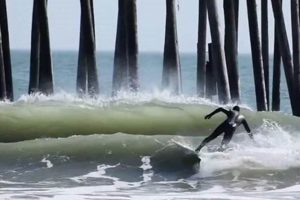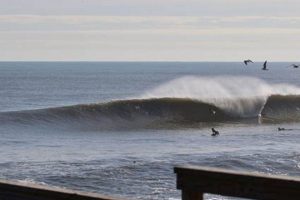Information detailing wave conditions, water temperature, and tides at a specific coastal location constitutes a localized marine forecast. These resources provide data essential for surfers, swimmers, boaters, and other ocean enthusiasts. For example, such a forecast might describe wave height, period, and direction for a particular day.
Access to reliable marine forecasts offers numerous advantages, enhancing both safety and enjoyment of coastal activities. Knowing wave characteristics allows surfers to choose optimal times to engage in their sport, while awareness of potential hazards like strong currents can help prevent accidents. Historically, observations from experienced locals formed the basis of this information; today, sophisticated technologies like buoys and numerical models contribute to its accuracy and scope.
This article will delve into the specifics of accessing and interpreting localized marine forecasts, the tools and techniques employed in their generation, and the practical implications of this information for various recreational and professional endeavors in coastal environments.
Interpreting Localized Coastal Wave Forecasts
Accurate interpretation of localized coastal wave forecasts is paramount for safe and fulfilling ocean activities. The following tips provide guidance on maximizing the utility of this information.
Tip 1: Consult Multiple Sources: Relying on a single forecast may lead to incomplete or inaccurate assessments. Cross-referencing information from several reputable sources, such as governmental agencies and established forecasting services, provides a more comprehensive overview of expected conditions.
Tip 2: Understand Wave Height Metrics: Pay close attention to distinctions between significant wave height, which represents the average of the highest one-third of waves, and maximum wave height, which indicates the occasional larger waves. Plan activities based on the former for a more realistic expectation.
Tip 3: Consider Wave Period: Wave period, the time between successive wave crests, is crucial. Longer periods typically signify more powerful waves and greater potential for strong currents and larger surf breaks.
Tip 4: Analyze Wave Direction: Wave direction influences which coastal areas receive the most direct wave energy. Onshore winds can increase wave size, while offshore winds may flatten waves and create cleaner surfing conditions.
Tip 5: Account for Tidal Influences: Tides can significantly alter wave behavior. High tides may reduce wave breaks, while low tides can expose hazards and create stronger currents.
Tip 6: Monitor Local Weather Conditions: Weather systems can drastically alter wave forecasts. Observe wind speed and direction, precipitation patterns, and approaching weather fronts for real-time adjustments to anticipated conditions.
Tip 7: Be Aware of Rip Currents: Rip currents are powerful, narrow channels of water flowing away from the shore. Identify potential rip current locations by observing breaks in wave patterns, discolored water, or floating debris moving seaward.
Implementing these strategies contributes to informed decision-making, enhancing safety and improving the enjoyment of coastal activities.
The subsequent sections will address the tools and technologies used in generating these forecasts and the broader implications of understanding coastal dynamics.
1. Wave Height
Wave height, a fundamental component of a coastal marine forecast, significantly influences the safety and feasibility of various water activities. Its accurate assessment within a specific area is central to understanding the complete coastal forecast picture.
- Significance for Surfing Conditions
Wave height directly determines the rideability of waves for surfers. A report indicating substantial wave height suggests conditions conducive to surfing, while low wave height indicates flat or minimal surf. Understanding the wave height is critical for surfers in selecting appropriate equipment and planning their surf sessions.
- Impact on Swimmer Safety
Excessive wave height poses hazards to swimmers. Stronger currents, increased turbulence, and greater potential for being swept out to sea accompany larger waves. A forecast indicating high wave heights advises caution and may necessitate restricting swimming activities to protected areas.
- Influence on Boating and Navigation
Wave height plays a significant role in determining the safety of boating and navigation. Choppy conditions and reduced visibility result from higher waves, demanding greater caution and experience from boat operators. Navigational challenges increase, particularly for smaller vessels, as wave height escalates.
- Contribution to Coastal Erosion
Persistent high wave heights can exacerbate coastal erosion. Increased wave energy impacts shorelines, accelerating the displacement of sand and vegetation. Monitoring wave height trends provides insights into long-term coastal changes and helps inform erosion management strategies.
In summary, the wave height component is integral to the broader understanding presented in coastal forecasts. By assessing wave height in conjunction with other factors like wave period, wind direction, and tide, one gains a complete and accurate picture of coastal conditions, allowing for informed decision-making in all coastal endeavors.
2. Wave Period
Wave period, measured in seconds, denotes the time interval between successive wave crests passing a fixed point. Within the context of coastal wave information, wave period assumes critical importance, directly influencing wave energy, breaking characteristics, and overall suitability for various water activities.
- Energy Dissipation and Coastal Impacts
Longer wave periods correlate with increased wave energy. These waves travel greater distances and release energy upon impact with the shoreline, potentially leading to increased erosion and altered sediment transport patterns. Coastal forecasts incorporating wave period data inform predictions of potential beach erosion events and coastal flooding.
- Surfing Quality and Ride Characteristics
Wave period significantly influences surfing conditions. Longer period swells often result in more defined, powerful waves suitable for experienced surfers. Shorter period waves generally produce less organized breaks and may be better suited for beginner surfers or bodyboarders. Coastal forecasts provide valuable insights for surfers seeking specific wave characteristics.
- Current Generation and Rip Tide Formation
Wave period affects the intensity and duration of coastal currents. Longer period waves contribute to stronger longshore currents and an increased risk of rip current formation. Awareness of wave period allows beachgoers and lifeguards to assess potential hazards and implement appropriate safety measures.
- Navigation and Vessel Stability
For maritime navigation, wave period plays a role in vessel stability and comfort. Longer period swells can induce pitching and rolling motions, particularly for smaller vessels. Coastal forecasts including wave period information assist mariners in planning routes and navigating safely in varying sea conditions.
Understanding wave period is essential for interpreting complete coastal assessments. Its integration with wave height, wind conditions, and tidal information provides a comprehensive understanding of coastal dynamics, allowing for safer and more informed decision-making by surfers, swimmers, boaters, and coastal communities.
3. Wind Direction
Wind direction constitutes a critical component of coastal wave information. Its influence on wave formation, wave quality, and overall coastal conditions necessitates careful consideration. Predominantly, wind generates waves; the direction from which the wind originates directly impacts wave direction and energy. Onshore winds, blowing from the ocean toward the shore, can increase wave size and create choppy, disorganized conditions. Conversely, offshore winds, blowing from the land towards the ocean, tend to groom waves, smoothing the water surface and creating cleaner, more defined surf conditions. For example, a report showing strong onshore winds will suggest rough surf unsuitable for recreational activities, while offshore winds might indicate favorable conditions for surfing. Understanding wind direction is, therefore, crucial for accurately assessing a coastal wave report.
Furthermore, wind direction’s impact extends beyond immediate wave characteristics. Sustained winds from a particular direction can influence longshore currents, affecting sediment transport and coastal erosion patterns. A long-term trend of onshore winds can contribute to increased beach erosion, whereas offshore winds might help maintain beach stability. In the context of maritime activities, wind direction affects vessel handling and navigation. Strong crosswinds can make maneuvering challenging, particularly for smaller boats. Combining wind direction with wind speed offers a more complete understanding. For example, a report indicating “light offshore winds” suggests optimal surf conditions, while “strong onshore winds” warns of potentially dangerous conditions for swimmers and boaters alike.
In summary, wind direction is a fundamental element of any localized coastal wave assessment. Its influence on wave formation, wave quality, and coastal processes makes it essential for making informed decisions about recreational activities and coastal management strategies. A comprehensive understanding of wind direction, in conjunction with other factors like wave height, wave period, and tide, is paramount for safe and enjoyable coastal experiences. Ignoring the role of wind direction can lead to misinterpretations of wave forecasts and potentially hazardous situations.
4. Tide Level
Tide level represents the vertical distance between the sea surface and a specified datum, typically mean lower low water. In the context of a localized marine forecast, tide level assumes a crucial role by significantly influencing wave characteristics, current patterns, and the accessibility of coastal areas. Its impact is directly observable in how waves break, where currents flow, and which parts of the beach are exposed or submerged. Consequently, tide level is an indispensable component for complete localized marine forecasting.
The interaction between tide level and wave action is complex. Higher tides often cause waves to break further offshore, potentially decreasing their intensity near the shoreline but also allowing waves to propagate into areas normally inaccessible. Lower tides can cause waves to break closer to shore, creating steeper, more powerful breaks favored by some surfers but also increasing the risk of hazards like exposed rocks or sandbars. Furthermore, tide level significantly affects current patterns, particularly in inlets and estuaries. Ebb tides, when water flows out to sea, can generate strong currents that pose a risk to swimmers and boaters. Conversely, flood tides, when water flows inland, can create calmer conditions in some areas but also introduce new hazards like rapidly changing water depths. Understanding these dynamics allows for better-informed decisions regarding water activities. Coastal forecasts offer tide charts correlating with wave parameters, which is vital when assessing risk factors.
In summary, tide level is not merely a static measurement; it is a dynamic factor that profoundly shapes the coastal environment. Its intricate relationship with wave characteristics and current patterns makes it an essential element of localized marine forecasting. Ignoring tidal influences leads to an incomplete and potentially inaccurate assessment of coastal conditions. A comprehensive localized marine report integrates tide level with other factors such as wave height, wave period, and wind direction to provide a holistic understanding of the coastal environment and enable safe and informed decision-making.
5. Water Temperature
Water temperature constitutes a crucial parameter within localized marine assessments. Its relevance extends beyond mere comfort levels, directly influencing various factors pertinent to activities and safety near Holden Beach.
- Influence on Aquatic Life and Ecosystem Health
Water temperature dictates the distribution and behavior of marine organisms. Deviations from optimal temperature ranges can trigger algal blooms, impact fish migration patterns, and affect the overall health of the coastal ecosystem. A significant shift may render an area unsuitable for certain species, ultimately affecting recreational fishing and other activities dependent on a healthy marine environment. Therefore, water temperature readings become a critical indicator for environmental monitoring efforts detailed in coastal zone data.
- Impact on Hypothermia Risk for Swimmers and Surfers
Prolonged exposure to cold water can lead to hypothermia, a potentially life-threatening condition. Lower water temperatures necessitate appropriate thermal protection, such as wetsuits, for swimmers and surfers. Coastal wave forecasts frequently include water temperature information to allow individuals to assess the risk of hypothermia and prepare accordingly. The absence of this information may lead to underestimation of the hazards.
- Effect on Wave Quality and Surf Conditions
While not as direct as wind or tide, water temperature can influence wave formation. Temperature gradients can contribute to localized weather patterns, which, in turn, affect wind direction and intensity. Temperature differences between air and water can create atmospheric instability, impacting sea breezes and overall surf conditions. Detailed regional analyses that consider the effects of temperature on local atmospheric dynamics are becoming integral to more comprehensive surf forecasts.
- Role in Coastal Fog Formation and Visibility
Significant differences between air and water temperatures can promote the formation of coastal fog, reducing visibility and creating hazardous conditions for boaters and swimmers. Colder water temperatures, particularly during certain times of the year, can increase the likelihood of fog formation. Coastal reports often include information on visibility alongside water temperature, enabling boat operators to assess navigational risks and make informed decisions about their activities.
The interwoven nature of water temperature with numerous aspects of the coastal environment underscores its value in informed marine data analyses. Integrating temperature data with other parameters strengthens the utility of coastal reports, assisting in managing resources and ensuring coastal activity safety near Holden Beach.
6. Rip Currents
Rip currents represent a significant hazard to beachgoers. A localized marine forecast must integrate information about their potential presence to adequately inform the public about risks associated with water activities.
- Formation and Identification
Rip currents are strong, localized currents flowing away from the shore. They form when waves break near the shoreline, creating a buildup of water that seeks the path of least resistance back to the ocean. They are often identifiable by a channel of choppy, discolored water moving seaward, a break in the incoming wave pattern, or floating debris moving offshore. A comprehensive coastal assessment incorporates observed and predicted rip current locations, allowing individuals to avoid hazardous areas.
- Impact on Swimmer Safety
Rip currents can quickly carry swimmers away from the shore, exhausting them and increasing the risk of drowning. Panic often leads swimmers to try to swim directly against the current, which is an ineffective strategy. A report that warns of rip currents advises swimmers to avoid entering the water or to swim parallel to the shore until they are out of the current’s flow. The inclusion of this information directly impacts swimmer safety by increasing awareness and promoting appropriate responses.
- Forecasting Techniques and Indicators
Predicting rip current formation is complex, involving analysis of wave height, wave period, wind direction, and tidal information. Numerical models and observational data are used to assess the likelihood of rip current development. Some reports employ color-coded risk assessments, such as flags or advisories, to communicate the level of danger. Effective dissemination of these forecasts is crucial for protecting beachgoers.
- Mitigation Strategies and Public Education
Beyond forecasting, proactive mitigation strategies and public education play a vital role in reducing rip current-related incidents. Beach patrols, lifeguard presence, and clear signage can alert individuals to potential hazards. Educational campaigns that teach people how to identify rip currents and how to escape them are essential for empowering beachgoers to make informed decisions. Accurate forecasts, combined with effective public awareness initiatives, contribute to a safer coastal environment.
Integrating details regarding rip currents in marine assessments enhances the ability to inform and protect the public. Disseminating rip current forecasts is crucial for minimizing risks and facilitating responsible enjoyment of coastal resources.
Frequently Asked Questions about Coastal Wave Assessments
This section addresses common inquiries regarding localized coastal wave assessments, providing clarification on their interpretation and application.
Question 1: What constitutes a reliable source for wave assessments?
Government agencies such as the National Weather Service, academic institutions involved in oceanographic research, and established private forecasting services with demonstrated expertise in coastal meteorology are considered reliable sources. Data from multiple sources provides a comprehensive overview.
Question 2: How often are wave assessments updated?
Assessments are typically updated multiple times daily, reflecting the dynamic nature of coastal conditions. More frequent updates may occur during periods of rapidly changing weather or significant marine events.
Question 3: What is the difference between “significant wave height” and “maximum wave height”?
“Significant wave height” represents the average height of the highest one-third of waves within a specified period. “Maximum wave height” indicates the height of the largest individual wave observed or predicted, which can be significantly larger than the significant wave height.
Question 4: How does wind direction affect wave conditions?
Onshore winds, blowing from the ocean towards the land, can increase wave height and create choppy conditions. Offshore winds, blowing from the land towards the ocean, can groom waves, resulting in smoother, more defined surf. Sideshore winds can generate longshore currents.
Question 5: Why is water temperature included in wave assessments?
Water temperature influences swimmer safety by affecting the risk of hypothermia. Additionally, water temperature can affect marine life distribution and coastal fog formation, impacting visibility and navigation.
Question 6: What actions should be taken if a wave assessment indicates a high risk of rip currents?
Individuals should avoid entering the water in areas identified as high-risk zones. If caught in a rip current, swimming parallel to the shore until free of the current’s flow is the recommended course of action.
A thorough understanding of coastal wave assessments equips individuals with the knowledge necessary for making safe and informed decisions regarding coastal activities.
The following section explores the technological advancements driving improvements in wave assessment accuracy and availability.
Conclusion
This exploration of the information available in a Holden Beach surf report underscores its vital role in coastal safety and recreational planning. The report’s components, including wave height, wave period, wind direction, tide level, water temperature, and rip current potential, collectively provide a comprehensive overview of dynamic coastal conditions.
Access to and careful interpretation of the Holden Beach surf report empowers individuals to make informed decisions, mitigating risks and maximizing enjoyment of coastal resources. Continued advancements in forecasting technology promise even more accurate and timely information, further enhancing coastal safety and responsible resource utilization.







